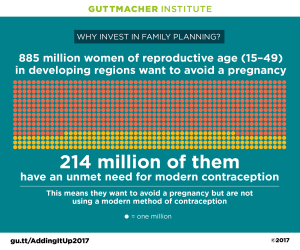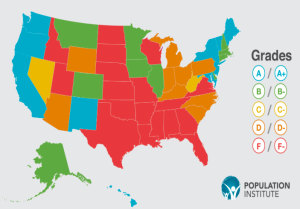Supporting What Women Want
Feb 26th, 2018 | By admin | Category: Family PlanningBy Suzanne York.
Given the chance, would you support something that many women say they want? Something that is not costly in the scheme of things?That “something” would be contraceptives and family planning services, and yet it is under threat in the U.S. and around the world (mainly because of the U.S. government).
The Low-hanging Fruit
Voluntary family planning is considered by reproductive health advocates to be “low hanging fruit,” meaning it has wide-ranging support and is relatively inexpensive. And most importantly, women want this and it improves lives in the U.S. and around the world.
The estimated current annual cost of modern contraceptive services in developing regions, covering 671 million women who are currently using modern methods, is $6.3 billion, including direct and indirect costs. This is one dollar per person per year in developing regions ($1.01).
Compare that to the recent proposed budget for the U.S. Defense Department – over $700 billion dollars. Or how much Americans spent celebrating Halloween last year – a record $9 billion.
The Trump administration has not been shy about its desire to gut reproductive rights, international family planning and global health initiatives. The latest proposed budget for fiscal year 2019 intends to cut international family planning assistance by half.
While it’s not likely that Congress would do that, even a Republican-controlled Congress, the very fact that this has been proposed shows a complete disregard for women, families, communities, and the environment.
Two health policy advocates with International Center for Research on Women recently wrote an op-ed that noted how the presidnet’s budget request included a recommendation to eliminate family planning assistance. This move would have ended a 50-year bipartisan history of supporting women and families through family planning and reproductive-health services. Once upon a time, George H.W. Bush was a big proponent of family planning. How times have changed.
Last year, the Guttmacher Institute released its figures on the benefits of international family planning assistance. The FY2017 budget of $607.5 million helped achieve the following:
- 25 million women and couples receive contraceptive services and supplies;
- 7.4 million unintended pregnancies, including 3.3 million unplanned births, are averted;
- 3.1 million induced abortions are averted (the majority of which are provided in unsafe conditions); and
- 15,000 maternal deaths are averted.
Regressing on Reproductive Rights Domestically
The situation, as many are aware of, is just as dire here in the United States. In fact, the Population Institute, in its sixth annual report card on reproductive health and rights in the U.S., gives the U.S. a “D-,” with 18 states getting a failing grade due to a prolonged “assault on reproductive health and rights.”
There is some good news. Eleven states (California, Washington D.C., Hawaii, Maine, Maryland, New Jersey, New Mexico, New York, Oregon, Vermont, and Washington) received an “A” in 2017, up from five the year before. Much of this is due to declines in these states in the rate of teenage pregnancy. Robert Walker, president of Population Institute, said, “America’s unintended pregnancy rate is the lowest it has been in 30 years and we have reached an historic low in the teen pregnancy rate.” Many of these states have implemented improved access to contraceptives (such as allowing pharmacists to fill prescriptions) and offer a year’s worth of birth control prescriptions, rather than the burden of having to refill a prescription every month.
Family planning assistance not only meets the needs of women in the U.S. and globally, but it also generates substantial health, economic and societal benefits for families and communities. It is even good for the environment. Meeting women’s needs for contraception and those who want a smaller family size would decrease population growth, a major contributing factor to environmental degradation throughout the world and straining many countries’ natural resources.
Let’s help provide women with what they want, and see how it ripples out to improve so much else in the world.
Suzanne York is Director of Transition Earth.

![One of the many signs at the Oakland Women's March, 01/20/18 [photo: Suzanne York]](http://populationgrowth.org/wp-content/uploads/2018/02/womens-march-1.jpg)

